
Author: Revelo Intel Translation: Shan Ouba, Bitchain Vision Realm
Understand Rollup’s economics principles
Ethereum’s scalability route chart is increasingly concerned about the Rollup solution, and with the continuous use of and expected EIP-4844, the second floor (L2) solution of the Ethereum is obtained.
However, the evaluation L2 solution is far from so simple.Unlike the L1 network such as Ethereum, the L1 network has a clear source of income from trading costs and clear expenses from tokens issuance, and Layer 2 solutions bring unique valuation challenges.
This report explores the complexity of the Ethereum Layer 2 solution, and in -depth understanding of the economic factors that support their value claims.
>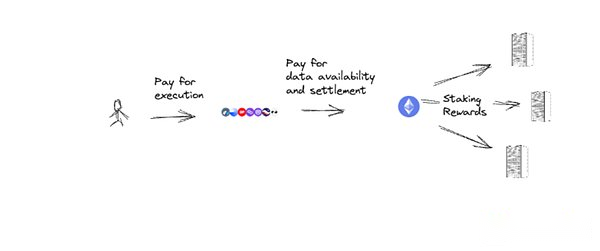
Overview
The progress in the field of ROLLUP solutions is undoubtedly impressive.Since the launch of Rollups in 2018, the influx of talents and research has brought significant progress.These include the introduction of Ethereum virtual machine (EVM) equivalent summary, the realization of bridges based on fraud and effective proof, breakthroughs in batch data compression, and the introduction of summary software development kit (SDK).It is worth noting that various Rollup solutions such as Optimism, Arbitrum, Base, ZKSYNC, and Starknet have entered the market and cultivated a booming ecosystem. With the intensification of market share competition, alternative L1 is in fragile and exposedThe status.
Although the current adoption rate has reached expectations and proved the feasibility of attracting the next generation of users, the growth trajectory of the second -level solution (L2) will accelerate in the next few months.With the emergence of EIP-4844 and the launch of new chains such as SCROLL, Linea, and Base, L2 is now the focus of attention.
EIP -4844: Pruning cost tree
The upcoming Dencun upgrade brings a significant feature EIP -4844, also known as Proto-Danksharding, which marks a significant decrease in operating costs related to summary.Although the specific norms of Danksharding have continuously developed, the seamless transition of EIP-4844 is the seamless transition of the Ethereum protocol structure, so as to adapt to the realization of future Danksharding.
>
The current ROLLUP implementation faces two main challenges.First of all, there are data storage bottlenecks because L2 handles millions of transactions, aggregates these transactions and submit transaction certificates to Ethereum.Secondly, transaction data from L2 to Ethereum will generate transaction costs.
>
The core of the EIP -4844 is the concept of “blob”, which means binary object.In essence, BLOB is a data block that links to transaction, which is different from conventional transactions.These BLOB data blocks are stored on the benchmark chain and generate the lowest GAS costs.They can add more data to the Ethereum block without increasing the size of the block.In short, compared with the size of the average block, using BLOB can increase the stored data by nearly 10 times.
>
The main purpose of BLOB is to significantly reduce the cost (DA) cost, especially for the first layer (L1) of the summary.Unlike the traditional methods in the CALLDATA space staying in Ethereum in the CALLDATA space in Ethereum, BLOB provides an efficient and economical alternative solution.Because the consensus layer management BLOB storage, BLOB transactions will not make additional requirements for the verification device.In addition, BLOB data will be automatically deleted within 30 to 60 days of proposed, which is in line with Ethereum scalability targets, rather than data storage at an unlimited period.
>
Prior to the implementation of the EIP -4844, L1 issued costs accounted for more than 90%of the total cost of ROLLUP.Looking forward to the future, EIP-4844 introduces the concept of “data gas”, which is a new cost category of BLOB transactions.This releases L2 data to the cost of Ethereum from the standard GAS Price.With the dynamic pricing based on BLOB demand and supply, L2 can significantly reduce costs when submitting data from Ethereum. Compared with the current GAS cost, the potential cost is as high as 16 times or amazing 90%.
>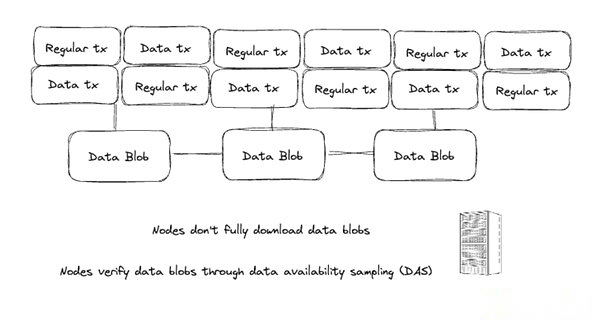
“‘Blob’ is like a data block, which can allow Ethereum to run more efficiently. They are stored separately without disturbing verifications and disappear when they are no longer needed. This means lower cost and more data space spaces, Make Ethereum faster and cheaper.
Rollup economics
To understand the importance of EIP -4844, it is important to master the business model of Rollups.This upgrade has led to a significant reduction in costs, and revenue expectations may remain stable or increase with the increase in chain activities.
In order to fully understand the impact of EIP-4844 on the summary economic model, it is necessary to analyze its income flow.Rollup’s income comes from network costs and miners withdrawal value (MEV), which is currently a source of capital controlled by monopoly MEV.
In terms of cost, the summary will encounter fixed costs and variable costs.The fixed cost comes from operations such as validity proof of the status root to the ROLLUP smart contract, ZK ROLLUP, and the basic transaction costs of Ethereum.Variable costs include L2 gasoline costs and L1 release fees required to store batch data on Ethereum.
>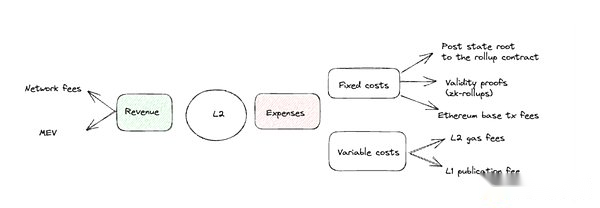
EIP-4844 introduces BLOB’s dynamic cost system, which is determined by BLOB supply and demand, independent of block space demand, which is different from traditional cost models.Therefore, the cost of Ethereum after the EIP -4844 includes two dimensions:
-
The conventional trading cost market based on EIP-1559: This dimension retains the established conventional transaction EIP-1559 cost market and has its unique developments, including the basic costs and priority costs that meet the principle of EIP-1559.
-
BLOB cost market: The second dimension introduces the BLOB cost market, which is completely determined by the current BLOB supply and demand.This creates an independent ecosystem different from the conventional transaction cost market to ensure that the cost of BLOB is not affected by fluctuations in block space demand.
The analysis of the EIP-4844 cost market reveals several notable results:
-
As the number of application chains and broad L2 increases, BLOB demand is expected to gradually increase.In the case of demand exceeding the BLOB target, the price discovery mechanism of the EIP-4844 may lead to rising data GAS prices.
-
As demand surges, the cost of data natural gas is expected to grow.If BLOB demand exceeds the target level, the cost of data GAS will experience rapid and index levels, which may increase by more than ten times within a few hours.Once the BLOB demand reaches the target price, the data GAS price will begin to grow at an index level every 12 seconds.
EIP-4844 changed the rules of how rollups make money and spend money.For dynamic BLOB costs, part of the cost market follows conventional rules, while the other part is self -adjusted according to the BLOB supply and demand.With the increase of BLOB demand, the cost of GAS has increased.
Rollups as a service (RaaS)
With the increase of the number of specific application chains, the business model of Rollups as a Service has become increasingly important.For example, compared with the specific application chain on platforms such as COSMOS, Ethereum Layer 2 has obvious advantages, which is mainly due to the emergence of RAAS solutions.
One key reason for this advantage is the reduction of infrastructure expenses.In the context of the second floor of Ethereum, this process has been significantly simplified due to the RaaS solution.These services simplify the deployment, maintenance and management of custom summary, and effectively solve the technical problems that developers often encounter when developing the main network.Therefore, RaaS enables developers to focus on application layer development, thereby increasing their overall productivity.
RaaS also provides a significant degree of customization.Developers can not only choose the preferred agreement of the implementation of the environment, settlement layer, and data availability layer, but also can also gain flexibility in key aspects such as setting sequencer structure, network costs, token economics, and overall network design.This adaptability ensures that RaaS can be customized to meet the specific needs and goals of various projects, thereby enhancing the multifunctionality of the Ethereum 2 -level solution.
We can distinguish between two main types of services:
-
SDK (Software Development Kit): These development frameworks used as ROLLUP deployment, including well -known options, such as OP Stack, Arbitrum ORBIT FOR L3s, Celestia Rollkit, and Dymension Rollapp development kit (RDK).
-
Non -code remittance deployment service: These services are designed for simplicity. You can deploy summary without deep coding professional knowledge.Eclipse, Cartesi, Constellation, Alt Layer, Saga, and Conduit and other solutions belong to this category.They reduce the entry threshold for developers and organizations interested in using RollUP technology.
We can also include the third category shared Sequence set, which can provide multiple summary services at the same time, such as Flashbots Suave or Espresso.
Although the current market structure may show that the demand for customized Rollup creation is not large, people generally expect that with the improvement of macroeconomic conditions and the more clearness of the product market.The emergence.
RaaS makes the work of developers simpler, faster, and more flexible.This allows them more time to determine the priority and focus on the core logic and business model of the application.
Questions about the practicality of L2 token
The success of the Rollup solutions such as Optimism, Arbitrum, Mantle, ZKSYNC, etc. is irrelevant.However, a subtle picture appears when it involves $ OP or $ ARB, such as $ OP or $ ARB.
Bear market case -limited room for rising space
In the traditional financial market, shareholders have a series of rights, including dividends, voting rights and asset claims. These rights provide inherent value for stocks and make it an attractive investment.On the other hand, tokens that only represent governance power lack such guarantees except voting for governance proposals.Since the sequence income generated by the transaction cost will not flow to the tokens, the growth of the network may not necessarily be converted into an increase in tokens.This has triggered a reasonable issue about the Rollup token value claim.
Although the right to govern has inherent value, especially in the Layer 2 solution with a significant influence of tokens (such as Optimism’s RPGF and Arbitrum’s STIP), because there is no dividend or other income flow, they becomeA different form of investment.
In today’s high interest rate environment, assets that do not provide actual yields may not be attractive, especially for conservative investors.The increase in interest rates has increased the cost of capital, making the opportunity cost of holding non -income assets more significant.In this context, although the Rollup tokens have growth potential, ETH, which has a stable STAKE, may be more attractive for investors who hate risks.
Bull market case -growth narrative
In the financial market, the value of the company is not only linked to profits or dividends.For example, the valuation of growth stocks depends on its long -term growth potential and re -investment strategy.Investment in ROLLUP to govern tokens can also be similar to investing in non -dividend growth stocks.
Historically, companies like Amazon choose not to distribute dividends, but invest in reinstatement in expansion and innovation.Investors in such companies do not necessarily seek instant return through dividends; on the contrary, they expect long -term growth and value appreciation.
Taking Optimism and $ OP tokens as an example, it clearly promises to reinstate the income to the growth of the ecosystem, thereby promoting a virtuous circle of increased demand for native DAPP, Sequencer and RPGF.In addition, with the emergence of superchain and other plans, the bandwidth of OP Stack continues to expand, and finally a strong moat that is difficult to ignore due to the network effect.
>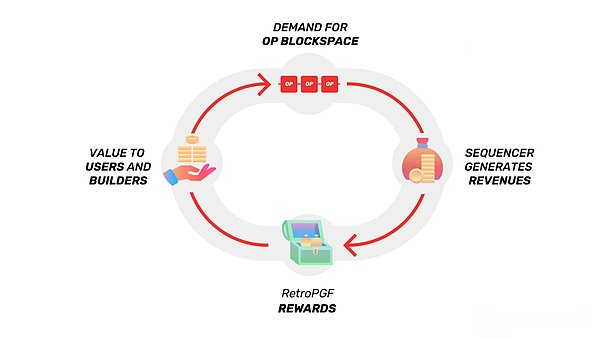
Industry outlook
The second floor (L2) pattern is evolving into a highly competitive field, and the hidden expectations of the airdrop can significantly affect any user behavior in any given L2.However, it is important to recognize that the valuation of a specific L2 is internal connection with the value of the first layer (L1), and the network effect is differentiated.
When we check the current summary function, this connection becomes obvious.They charge gasoline fees in ETH, and they must pay data availability fees to Ethereum in the form of ETH.In essence, these summaries lack the ability to implement their monetary policy; Ethereum stipulates how much they must pay to the underlying chain.
Therefore, L2 does not have obvious currency premium.However, the current transaction method of L2 token does not always conform to this reality.However, as long as they can build a strong ecosystem and cultivate network effects, these second -level entities have the potential to become a sovereign entity in the future, and the market may seek prediction and seize this opportunity.
Airdropping will definitely affect the behavior of users.But there is a turning point here: the value of L2 is closely related to Ethereum (L1).L2 is charged and paid with ETH, so they do not have their own funding rules.
In this context, it is clear that the current L2 operates in the way of price spread: they charge the end users and retain some of the costs to pay the settlement and data availability cost of Ethereum.Having related governance tokens is actually equivalent to part of the spread generated by L2.
>
When multiple instances can be created, things will become more interesting, just like the situation of Optimism.In this case, the spreads generated by these instances can flow back to the token holders.Taking Base as an example, it distributes 10% of the cost to Optimism.
>
This model releases the greater potential of L2 asset scalability, creating a precedent for part of the hidden license agreement and part of the fiscal part of the fiscal part.This dynamic not only increases the depth of the L2 ecosystem, but also strengthens the value proposition of L2 token with the development and adaptation of L2 to the competitive pattern.
Current situation
At present, the transaction price of Ethereum is about $ 195 billion, and it is expected that its value will increase simultaneously with the growth of Rollup above it.In addition, the launch of ROLLUPS, the launch of the service (RaaS) is expected to bring the extension of the universal and specific application RollUp entering the market.
>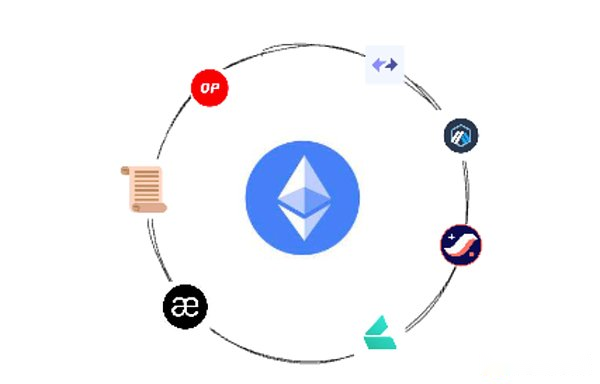
However, although we can expect the value of the basic layer, compared with ETH, L2’s trading Beta value is usually higher.In addition, investors may regard their tokens as bets on the entire ecosystem.We recommend using this method carefully, because each item will migrate its code library and users to the latest and most popular L2 at any particular moment.
In addition, L2’s positioning is to attract more users, thereby increasing the value of returning to Ethereum.This dynamics may follow the distribution of power law, although the degree of the degree observed in the migrant pledge.Therefore, it can reverse the point of view and think that ETH is the actual index that investors may be more willing to own.As more and more L2 enters the market, and DAPP is finally distributed on multiple L2, choosing to win the chain becomes more complicated.Nevertheless, no matter who the final winner is, the $ ETH holder and the Ethereum verification will benefit.
The value of Ethereum will rise with the growth of Rollups, and Rollups is service (RAAS) will bring a wave of RollUps to the market.
The volatility of L2 is different from ETH, and the project can be quickly switched between L2.
L2 will attract more users and benefit ETH holders and verificationrs, but it is tricky to choose the winner in L2.
Finally, holding ETH may be the safest choice.
Do we still need to replace L1?
The era of L1 rotation seems to have become the past.With the effective solution of Ethereum’s scalability challenges to the 2nd floor (L2) solution, questioning the value proposition of the value of the 1st level (L1) blockchain (such as Near, Avalanche, Solana, FANTOM, etc.) is necessary.
A key difference is that it is easy to guide the total value lock (TVL).L2 enjoys an advantage in this regard, because users and developers are already familiar with tools available on Ethereum.They only need to connect the asset bridge to the L2 chain to use the reduced transaction cost.In essence, TVL, which was originally on Ethereum, just sought a more cost -effective trading environment.
However, it is important to recognize that alternative L1 still serves specific purposes and provides unique features that may attract some use cases.
-
Diversified ecosystems: alternative L1 cultivates its own ecosystem, usually with unique communities, projects and innovations.These ecosystems may cater to niche markets or specific industries.
-
Professional functions: Some L1 will give priority to functions such as high throughput, low latency or specific consensus mechanism.These attributes may make them more suitable for certain applications, such as high -frequency transactions or games.
-
Diversification: From an investment perspective, diversification across different levels can reduce risks.Although Ethereum still dominates, other L1 may provide diversified opportunities.For example, betting solana can be a way to fight EVM (imagine scenes that find zero vulnerabilities in EVM).
The surviving L1 will be L1 (Solana, Monad, etc.) that bring unique value to the ecosystem.It is not enough to provide EVM compatible chains and lower GAS fees.This seems to be obvious now, but in the past, many examples have shown that the EVM compatibility chain with lower GAS costs has reached huge valuations.Take the EVM compatible chain Moonriver on Kusama (Polkadot’s Golden Silk Chain) as an example. The chain reached a historical high of $ 494 in the fourth quarter of 2021, and the current transaction price is $ 4.
>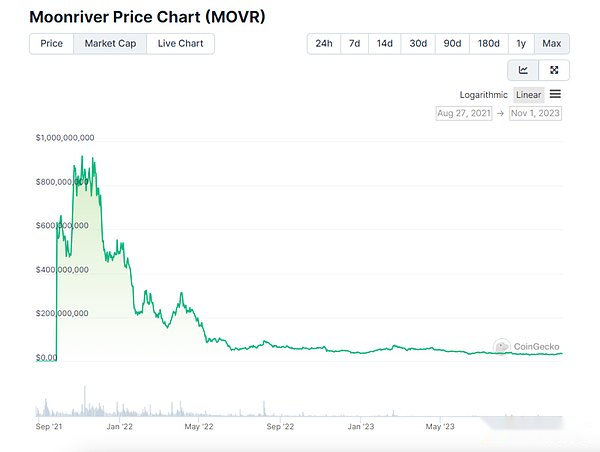
L2 reduces the needs of the L1 round of transactions.Although the replaced L1 blockchain is still unique, L2 has an advantage in TVL because they provide familiar tools and lower transaction costs.
However, a variety of ecosystems, professional functions and diversification can make alternative L1 attractive to specific cases and risks.
The surviving L1 will bring the unique value beyond EVM compatibility and lower GAS costs
Point
-
The traditional valuation method is more suitable for L1, transaction costs are income, and tokens issuance as expenses.L2 brings unique challenges to valuation.
-
Although cryptocurrencies and stocks have different structures, basic investment logic is still applicable -assets with long -term growth potential may also be an attractive strategy.
-
L2 operates by the capture price difference. When the chain forms a hidden income sharing agreement, this model will be strengthened. For example, Base distributes 10% of the cost to the Optimism Finance Department.
-
$ ETH can be regarded as an “index” asset, and the function of L2 is like a personal “stock selection”.No matter which L2 is the most active, $ ETH holders and Ethereum verifications will benefit from the increase of the ROLLUP activity.
in conclusion
One way to look at this issue is that EIP4844 will significantly reduce the cost of L2, and its income will increase over time.The difference between the two is the profit margin of these L2.With the expansion of spreads, they decided to start to share with tokens to share these profits.If you are willing to wait for all parts of the puzzle, it is a reasonable method to run the logic in advance.
It is obvious when we draw the future drawing route for the future of ROLLUP such as $ OP or $ Arb, and the pattern is ready to transform.The emergence of EIP4844, ERC4337, and the emergence of RAAS featuring SDK and unparalleled deployment services, will soon usher in the wave adopted by rollup.
This wave may appear tens of thousands or even tens of thousands of summaries.However, investors have different views on the value of token value.On the one hand, challenges that lack the traditional value capture mechanism and the impact of high interest rate environment may limit the potential rising space of the Rollup tokens.On the other hand, some investors may compare these tokens to non -dividend growth stocks such as Google, Amazon and Tesla, and recognize that they have achieved higher valuation potential driven by long -term growth prospects.
When we adventure enters a more intense competition environment, considering the dynamics and unique characteristics of Rollup’s development of tokens, maintaining adaptability is essential.








